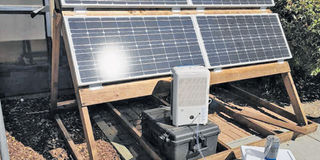Trio bets on sun, tech and air to solve water problems

Majik Water’s atmospheric water generator, which uses solar power to convert humidity into water. PHOTO | COURTESY
It may not come as a surprise that Beth Koigi, a 26-year-old who grew up in Kimende on the outskirts of Nyahururu Town, is trying to solve water problems.
Her father uses water supply technology to irrigate his farm, one of her brothers runs a company that makes water gutters and roofing, while the other is a water engineer who builds dams.
With a master’s in project planning and management from the University of Nairobi, Beth also set out to solve water problems, an idea whose seed was planted during childhood when she watched villagers fetching water downhill make laborious trips uphill with the precious liquid in jerry cans balanced on their heads.
Her first attempt at fixing water problems was as a first-year college student. Tired of battling waterborne infections, but too broke to afford a water purification system, she made a do-it-yourself water filter.
Her colleagues took an interest in her innovation and asked her to make them filters, which she distributed free of charge. These experiences watered the seed of developing a community water generator in her mind.
“There’s a big link between water scarcity and water contamination. People with little water may not bother to filter it, hence getting exposed to waterborne diseases. I also wondered why we spend so much time and energy to fetch and transport water while there is atmospheric water generation technology that can be utilised to access the water right where we are,” Beth told HealthyNation.
GREATEST CHALLENGE
With her idea in the pocket, Beth applied for the Global Solutions Program that saw her join the Singularity University at the Silicon Valley in the US – the innovation capital of the world – where she met her partners Clare Sewell and Anastasia Kaschenko, and Majik Water was born.
Ms Clare Sewell, a financial strategy consultant with a BSc in Economics and Management, has 10 years’ experience of strategy consulting and runs her own startup in Malawi. Water harvesting specialist Anastasia Kaschenko, who serves as the firm’s chief technology officer, holds a BSc in environment from Trent University and also does research and development at tech firm Carbon Upcycling Technologies. “We were connected by the same need to see a world where everyone has access to adequate and clean drinking water,” says Beth, adding that there is six times more water in the atmosphere than in all rivers around the world.
“Our planetary atmosphere is a source of clean drinking water that has not been utilised. But this concept of harvesting water from air is not entirely new as ancient communities including Africans and Kenyans have used it to harvest dew,” she says.
Majik Water’s greatest challenge has been using solar energy. The firm is exploring different ways to make the system easier to use and affordable for all. Other challenges include the need for a lot of energy to condense water directly from the air. To resolve the challenge, Majik Water is using materials with high affinity for water molecules in air which easily capture these molecules, heats them and collects the water vapour released. This makes the technology more energy-efficient.
Also, most of the technology that exists harvests dew, fog, mist or water in high humidity of 60 per cent and above. They have tackled this by tweaking their device to work in low humidity of 35 per cent as is common in most arid and semi-arid areas in Kenya.
The three women scooped first prize of 15,000 Euros (Sh 1.9 million), beating 96 other startups from Africa, at an innovation contest in France. This money, they hope, will help them move their device from idea to commercial viability.
This comes at a time when biting water shortages are becoming more problematic in Kenya and the world at large.
“Over 700m people do not have access to clean and safe water worldwide. 319 million of these are in sub-Saharan Africa. In Kenya, 12 million people do not have access to adequate clean drinking water. Most worryingly, water shortages are predicted to get much worse over the next decade,” Beth says.
By 2025, the UN estimates that 1.8 billion people will face absolute water shortage around the world and two-thirds of the world’s population will be living in water-scarce areas.
For this reason, the world needs to find innovative ways to provide water for a growing population.



